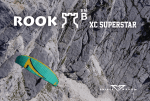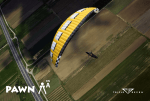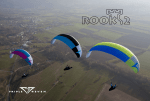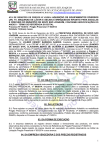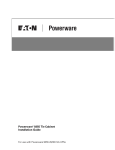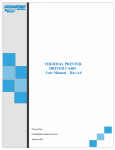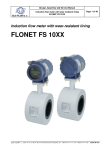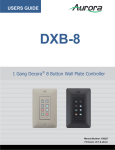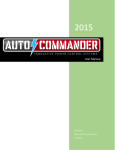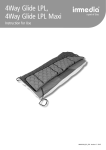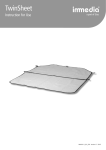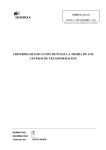Download LTF / EN - Triple Seven Gliders
Transcript
LTF / EN C High performance EN/LTF-C USER MANUAL Version 1.2, Date: 11.12.2014 Introduction Welcome Welcome to the Triple Seven Team! We are excited that you have chosen to fly the QUEEN. Queen is developed for maximum performance while maintaining the ease of flight of EN/LTF-C class glider. This glider is designed to be your next step in XC and competitions flying. We wish you exciting flying adventures! Triple Seven Mission Our company’s goal is to produce high quality products and technologically innovative gliders of all types and classes. We are striving to develop state of the art paragliders, with the optimum compromise between safety and performance.Your success is our inspiration; our goal is your success. Manual This document contains complete product information and instructions to familiarize you with the main characteristics of your new glider. It contains instructions on how to use and maintain the wing, however, its purpose is not to serve as learning material to pilot this kind of wing. As such, this is not a flying manual. Flying instructions can only be taught by flying schools and specially certified instructors. It is important that you take time to read this manual carefully before the first flight, as thorough knowledge of your equipment enables you to fly safely and to maximize your full potential. If you borrow or give your glider to another pilot, please pass this manual on with it. If any use of Triple Seven equipment remains unclear after having read this manual, please contact: your local paragliding instructor, your Triple Seven importer or Triple Seven. This product manual is subject to changes without prior notice. Please check www.777gliders.com for the latest information regarding our products. Summary 1.LTF / EN 2.C 3.High performance EN/LTF-C IV. Introduction IV.i. Welcome IV.ii. Triple Seven Mission 5.QUEEN 5.1.Designer’s thoughts 5.2.Who is this glider for? 5.3.Certification 6.Before flight 6.1.Elements, components 6.2.Assembly 6.3.Harness 6.4.Accelerator settings 6.5.Brakes’ adjustments 6.6.Weight range 6.7.Wing inflation 6.8.Modifications on the glider 6.9.Preflight safety 7.Flying QUEEN 7.1.First Flight 1 1 3 4 4 4 7 8 9 9 10 10 10 11 11 11 12 12 12 12 13 13 7.2.Preflight check equipment 7.3.Final preflight check 7.4.Inflation, control, take-off 7.5.Line knots or tangles 7.6.Normal flight, best glide 7.7.Minimum sink 7.8.Accelerated flight 7.9.Active flying 7.10. Flying in turbulence 7.11. Fast decent techniques 7.12. Winch launch 7.13. Aerobatics 7.14. Primary controls failure 7.15. Landing 8.Maintenance 13 14 14 14 15 15 15 15 16 17 19 19 19 19 20 10.1. Technical data 26 8.1.General advice 8.2.Packing instructions 8.3.Storage 8.4.Cleaning 8.5.Repair 8.6.Checks and control IX.Packing QUEEN 10.Technical data 20 20 21 21 21 21 22 24 10.2. Materials description 26 10.3. QUEEN risers arrangement 27 10.4. Line plan QUEEN 28 10.5. Line lengths QUEEN M 29 XI.Safety and responsibility 30 XII. Guarantee 31 XIII. Registration information 32 XIV. Get involved 32 XV.Contact 33 rle STE lr ldw BPI »Reinforced » leading edge (RLE), Smooth trailing edge reinforcements (STE) together with (BPI) for greater stability and good gliding performance on wide speed range »BPI » - back position intake technology for spin and stall resistance and good stability at accelerated flight. »Low » induced drag wing tip (LDW), optimized washout with two additional floating cells. »Three » liner concept, with considerable line reduction (LR) »4 » cells diagonals (RLE) reinforced leading edge »Good » pitch stability and ease of piloting »Trim » speed optimized for good climbing »Clean » canopy with refined sail tensions »Direct » handling with precise control »Full » span distributed panels orientation streamlined to airflow direction »Improved » 3d shaping (ballooning) at the leading edge »High » top speed »Easy » launch control »Highend » EN/LTF-C glider 6 7 Designer’s thoughts My goals while developing this glider was to make high performance XC machine and competitions introductory glider with EN/ LTF-C class ease of flight. While designing this wing for performance, we gave great emphasis to refined sail tension internal construction and line reduction. For this glider we designed completely new profile evolved from experimental two liner King glider. Queen is three liner with considerable total line length reduction. Together with current two liner technology we are using also new full span distributed panels orientation streamlined to airflow direction. I was quite impressed with the prototype performance while testing it in Mexico Valle de Bravo. Queen was flying fantastic compared to other gliders but for me the most important was stability and usability in strong conditions. Aljaž Valič Who is this glider for? Queen is EN-C, LTF-C class glider, designed for intermediate and advance pilots. This glider is developed for maximum performance in its class and beyond. Our effort with this glider was to make XC machine to satisfy the high end intermediate and advanced pilots who wants maximum performance and comfort of EN/LTF-C class. Certification The QUEEN has passed the European EN-C certification for all commercially available sizes. The homologation results are enclosed at the end of this manual. 8 9 Before flight Elements, components The QUEEN is delivered together with a backpack, inner bag, glider strap, Triple Seven T-shirt and USB key with this manual. Assembly Before you rush to the first take-off we recommend you take your time to unpack and test your equipment on a training slope. In this way you will have time and will not be distracted or rushed to prepare your equipment, and you will be able to do your first pre-flight check properly. The place should be flat, free of obstacles, and with light wind. This will enable you to nicely inflate the wing and also familiarize yourself with it while ground handling. Every glider has to be checked by a Triple Seven dealer, however, as a pilot you want to do a proper pre-flight check yourself. Firstly, prepare and spread out the glider like you would normally do. While you are spreading out and walking along the glider, observe the fabric material for any abnormalities. When you are done with the inspection of the canopy, grab the risers and spread the lines, check if the risers and maillons (carabiners) are properly closed. Identify and disentangle the A1, A2, B, C risers and the lines including the brake lines. Connect the risers’ main 10 attachment points correctly to the harness, watch for any twists and make sure that the main carabiners are properly closed. Accelerator settings The QUEEN has passed EN-C certification testing using a GH ABS type harness. This certification allows the QUEEN to be flown with most of the harnesses on the market, but keep in mind that the change of a harness greatly influences the feeling of the glider, depending on the effectiveness of the harness weight shift. Check with the harness manufacturer or with your instructor whether your harness is of the proper type. Before attaching the accelerator system to the QUEEN risers, check that the speed system inside your harness is correctly routed and that all pulleys are set correctly. Make sure there are no knots or other obstacles that might make the accelerator get stuck during usage. Harness The length of the harness chest strap affects the distance between the main carabiners and the wing’s handling as well as your stability in the harness. Tightening the chest strap increases your stability, but greatly increases the risk of twisting after a collapse. A tight setting also increases the tendency to maintain a deep spiral. As a rule of thumb, a more opened chest strap gives you more feedback from the glider, which is good for your climbing efficiency and increases safety in a flying incident. But we strongly recommend adjusting the length of the harness chest strap according to the lengths used during certification. This setting varies according to the harness size from 42cm to 50cm. Check the settings used during testing under the certification specimen section.We recommend that your first flight with the QUEEN is not also with a new harness. Another rule of thumb is if you want to experience the feeling of new equipment, change only one part of equipment at a time. The QUEEN speed system increases the speed of the glider by 20km/h with the accelerator at full travel, from trim speed at 40km/h to full speed at 60km/h. The length of the speed bar lines should be adjusted on the ground so that your legs are fully extended at the point of full accelerator travel. While setting the speed line lengths make sure they are long enough, so that the speed system does not accelerate the glider by itself. If in doubt how to properly set the accelerator system, please consult your instructor or Triple Seven dealer. Brakes adjustments The length of the brake lines has already been adjusted by the manufacturer and is the same as used during the certification test flights. The length is set and fine-tuned during the development of the glider, therefore generally there should be no need to adjust them. We recommend flying this setting for a while, and you can still change it afterwards if you wish to do so. If you change the length of the brakes, do it in a step by step process of 2 cm at a time. Bear in mind that if you make the brake lines too short, they might be applied unintentionally while the speed system is being used. 11 Weight range Each size of the QUEEN is certified for its own weight range. The above mentioned weight includes the weight of the pilot and complete paragliding equipment, together with the glider, harness, all accessories and optional ballast. Every glider changes its characteristics by changing the take-off weight. We recommend that you always fly your glider in the specified weight range. To measure your take-off weight, step on a scale with all your equipment packed in the rucksack. Lower half of the weight range Flying the QUEEN, as any other glider, in the lower part of the weight range, causes the agility of the glider to decrease, and when flying through turbulence its tendency for collapses relatively increases as compared to flying it in the upper wing loading range. However, reactions after a collapse are less dynamic and sink rate improves. Therefore, if you mainly fly in weak conditions, you might prefer this weight range. Upper half of the weight range Again, as with any other glider, flying the QUEEN in the upper part of the weight range increases the stability and agility of the glider. Consequently, there is a slight increase in the glider’s speed and also gliding performance, especially when flying against the wind. If you normally fly in stronger conditions and you prefer relatively more dynamic flying characteristics, you should set the take-off weight in the higher weight range. Reactions after a collapse may be more dynamic in the upper half of the weight range. 12 Wing inflation Still being on the training slope and having prepared and checked everything, inflate your wing and play with it to get a feel of your new glider while ground handling. By doing this you are making a final check of the canopy and lines, and that everything is in order. You will find that the QUEEN inflates very easily and smoothly without excessive energy and with minimum pressure while moving forwards. For inflation and lifting the glider you may use only the A1 risers. Do not pull on the risers just with your hands, instead use your whole harness. Your hands should only accompany the rising movement of the wing. When the wing is above you, apply correct pressure on the brake lines and the glider will stay above you. Modifications on the glider Any modifications of the lines or risers’ speed system cause the loss of the certification, similarly to flying the wing outside the weight range. Preflight safety Before flying the QUEEN, you should obtain all practical and theoretical training and the certification for flying this kind of wing. Pilots should be physically and mentally fit, using complete paragliding equipment and flying only in conditions suitable for their level of flying expertise. Flying QUEEN First Flight Now that you have already familiarized yourself with your new glider while ground handling on a training slope, you are ready for your first flight. For the first flight it is recommend that you choose a familiar flying area and to fly your new glider in calm conditions. Preflight check equipment Before every flight you need to do a pre-flight check and the inspection of other equipment. Learn to do this, as it takes no extra time. This procedure may vary, depending on the instructor, pilot or equipment settings. Some pilots have their wing always connected to the harness. However you should have a consistent method of checking and preparing your equipment and doing the final pre-flight check. 1. After the arrival on take-off, assess the suitability of flying conditions. 2. While walking around the canopy preparing and spreading out the wing, you should at the same time inspect the canopy. 3. After you check the lines and connect the risers to the harness, grab the lines and slide them through your fingers as you walk towards the canopy. In this way you double check that the lines are not tangled, stuck or damaged. If meanwhile the canopy 13 moves, walk around and correct it again. 4. Inspect the harness, reserve, speed system and all connections. Final preflight check 1. Strap into the harness. The leg straps should be the first to be connected on the take-off and the last ones to be released after the flight. Make sure you are strapped in correctly and wearing a helmet. 2. Check the risers for a twist and that the carabiners are properly closed. Check if the speed system is not affecting your risers – accelerating unintentionally. 3. Check the lines. The A riser lines should be on top, and all lines untangled. Check if none of the lines are lying over or below the canopy. 4. Check the canopy. The glider should be spread out in the shape of an arch and all cells open. 5. Check the wind, take-off and airspace. The wind should be favourable for take-off and the pilot’s level of expertise. Airspace should be cleared, together with the take-off area. Inflation, control, take-off The QUEEN has easy take-off behavior and does not require any additional advice regarding the forward or reverse launch. Try to divide and practice the take-off procedure in three steps. 1. Inflating and raising the glider 2. Controlling the wing and wing check 3. Accelerating and take-off 14 It is always advisable to practice and improve proper launching techniques as this reduces unnecessary additional stress before the take-off. Wind speeds up to 25 to 30km/h are considered strong and extra care is required for the flight. If you are launching in strong winds we recommend the reverse launch technique, with your brakes in the right hands at all times. Launch the glider with a gentle pull and then walk towards it if necessary to reduce the relative wind force. When the glider is above you, gently control the wing and take off. Line knots or tangles If you fail to observe a line knot or you find yourself flying with a knot before being able to prevent the unintentional, uncontrolled take-off, try to stay away from the ground or other pilots by flying away from the mountain, before taking any corrective action on the wing. This means that you weight shift and/or counter brake the opposite side of the wing and control the flying direction with the least amount of force needed for the wing to fly straight away from the mountain. Be careful not to apply too much brake or to fly too slowly to avoid a stall or spin. When you are at a safe distance away from the mountain and you have gained relative height by flying away, you may want to gently and briefly pull the lines that are tangled with the knot. If the knot is on the brake lines you might want to gently and briefly “pump” the appropriate brake line. Please note that by pulling the lines, the knot may get stuck in a worse position and the situation may escalate also to a stall or spin. Therefore, if you estimate that you can control the wing relatively safely and that the knot is not released by gently and briefly pulling the tangled lines, immediately fly to the landing zone and land safely. Normal flight, best glide Without any brakes applied and without using the accelerator, the wing flies at the so called “trim speed“. In calm air this is theoretically the best glide speed. The best speed glide depends on the glider’s polar and air mass, vertical and horizontal speed. We recommend reading more about the theory of the best glide and McCready theory. Minimum sink If you apply brakes on both sides for about 10 -15 cm you will slow the glider to the theoretical minimum sink speed. But we do not recommend using this speed even for thermalling, as you achieve much better climbing and control by letting the glider fly with its “trim speed” and natural energy. With a proper take-off weight you will find that the glider has great climb, reactions and agility. Accelerated flight After you get comfortable flying the QUEEN, you can start practicing using the speed system, which will provide better performance while gliding against the wind and through a sinking air mass. The QUEEN was designed to be stable through its entire speed range, but this requires the use of active flying techniques. Note that any glider becomes less stable while flying accelerated and that the risk of a collapse is higher in accelerated flight. Additionally, the reaction of the glider to a collapse in accelerated flight is more radical in comparison to the one which occurs at trim speed. We recommend that you avoid accelerated flight near the ground and to be very careful using the accelerator in turbulent conditions. Use a soft speed bar, which enables you to accelerate the glider by using only one leg. To control the direction use weight shift. To control the pitch change the amount of the speed bar. Do not use or pull the brakes while using the speed bar. Use the speed bar progressively when accelerating and instantly release when you feel a slight loss of tension, pressure or even a collapse. If you encounter a collapse while using the accelerator, release the speed bar immediately before taking any other corrective action. Always keep more distance from the ground when using the speed bar. Active flying This is a basic flying technique for any pilot. It implies permanent control and the correction of pitch and roll movements together with the prevention of any deflations or collapses. In a nutshell this means flying straight through active or turbulent air, so that the pilot keeps the glider above his or her head at all times, compensating and correcting any unwanted movements of the wing. Few examples: • While entering a strong thermal, the wing will stay a little bit behind relative to the pilot. The pilot should let the brake up allowing the wing to fly faster and to catch up. • If the wing surges in front of the pilot, the pilot should counter brake until the surge is controlled and then release the glider 15 • to let it fly normally. If the pilot feels a loss of tension on the wing or a loss of pressure on the brakes on one side of the wing, he should smoothly apply the brake on the side with loss of pressure and/ or weight shift to the opposite side until the pressure returns. After that, again release the brake and/or weight shift to the neutral position and let the glider fly normally. The key in all cases is to avoid an over-correction and not to maintain any correction longer than necessary. After each action let the glider fly normally again. To re-establish its required flying speed. You can train or get a feeling for most of these movements safely on the ground while ground handling your glider. Good coordination of your movements and coordination with the wing on the ground will enable you a quick progression when actively flying in the air. The next step is to attend SIV courses where you should also get a better understanding of the full brake range and the glider’s speeds. Flying in turbulence Wing deflations can occur in a strong turbulence. The QUEEN is designed and tested to recover without pilot’s input in almost all situations by simply releasing the brakes and letting the glider fly. To train and understand all the manoeuvres described, attend SIV courses. Cascade of events Many reserve deployments are the result of a cascade of over-corrections by the pilot. Over-corrections are usually not 16 problematic because of the input itself or its intensity; but due to the length of time the pilot continues to over-handle. After every input you have to allow the wing to re-establish its normal flying speed. Note that over-corrections are often worse than no input at all. Asymmetric deflations Strong turbulence may cause the wing to collapse asymmetrically. Before this occurs the brake lines and the feeling of the harness will transmit a loss of pressure to the pilot. This feedback is used in active piloting to prevent a collapse. If the collapse does occur, the QUEEN will easily re-inflate without the pilot’s reaction, but the wing will turn towards the collapsed side. To prevent this from happening turn and actively recover the asymmetric collapse by weight shifting and applying appropriate brake input on the side that is still flying. Be careful not to over-brake your wing’s flying side. This is enough to maintain your course and give the glider enough time to recover the collapsed side by itself. To actively reopen the collapsed side after course stabilization, pull the brake line on the collapsed side firmly and release it. You can do this several times with a smooth pumping motion. After the recovery, release the brake lines for your glider to regain its trim speed. You must be aware of the fact that asymmetric collapses are much more radical when flying accelerated. This is due to the difference in weight and the inertia of the canopy and the pilot hanging below. Symmetric deflations Symmetric or frontal deflations normally reopen immediately by themselves without pilot’s input. The glider will then regain its airspeed accompanied by a small surge forwards. To actively control this event, apply both brakes slightly when the collapse occurs and then instantly release the brakes to let the glider fly. Be prepared to compensate for the glider’s slight surge forward while returning to normal flying. Wing tangle, cravat A cravat is very unlikely to happen with the QUEEN, but it may occur after a severe deflation or in a cascading situation, when the wing tip gets caught in the glider’s lines. A pilot should be familiar with the procedure of handling this situation with any glider. Familiarize yourself with the stabilizer’s main line (“stabilo” line (outsied line on B riser) already on the ground. If a cravat occurs, the first thing to do is to try to keep the glider flying on a straight course. Do this by weight shifting and counter braking the untangled side. After that, grab the stabilizer’s main line on the tangled side and pull it down until it becomes tight again. At this point the cravat normally releases itself. Possible solutions of the cravat situations (consult your SIV instructor): • Pulling the wing tip “stabilo” line • Using a full stall, but it is essential to be very familiar with this manoeuvre. You also want to have a lot of relative height. • If you are in a situation where you have a cravat and you are low in rotation or even with twisted risers, then the only solution is the reserve parachute. Negative spin In normal flight you are far from negative spin. But, certain circumstances may lead to it. Should this occur, just release the brake lines progressively and let the wing regain its flying speed. Be prepared for the glider to surge forward, compensating the surge with brake input if necessary. Full stall A full stall does not occur unintentionally on its own – it happens if you pull both brakes for 100% and hold them. The wing then performs a so called full stall. Releasing the brakes improperly may lead to massive surge of the glider with danger of falling into the canopy. This is a complex manoeuvre and as such outside the scope of this manual. You should practice and learn this manoeuvre only on a SIV course under professional supervision. Deep stall Generally when in deep stall, the wing has no forward motion and at the same time high sink speed. When in deep stall the wing is almost fully inflated. With the QUEEN it is very unlikely to get into this situation unintentionally. This could possibly happen if you are flying at a very low speed in turbulent conditions. Also the porosity of the material and line stretch on a very old glider can increase the possibility of the deep stall tendency. If you trained this manoeuvre on a SIV course you would realize that it is very hard to keep the QUEEN in deep stall. If you apply the brakes a little bit too much you enter the full stall. If you release the brakes just a little bit too much the wing returns to normal flight. If you want to practice the deep stall on SIV courses, you need to master the full stall first. Fast decent techniques Fast descent techniques should be well familiar to any pilot as they are important resources to be used in certain situations. These 17 manoeuvres should be learned at your flying school as a part of paragliding pilot training. Nevertheless, we recommend practicing these manoeuvres on SIV courses under professional supervision. Big ears This is a safe method to moderately loose altitude while still maintaining forward speed. To do big ears, release any brake line loops around your wrist, set your leg on the speed bar, but do not push it. Now pull the outer A lines (the A2 risers in the drawing) on both sides. As long as you keep the A2 risers pulled, the wing tips stay folded and the sink speed increases. To regain normal flight, release the A2 risers, and if necessary apply the brakes with short impulse movements. Release big ears at least 100 meters above the ground. While using big ears, the wing speed decreases, which is why we also recommend using the accelerator half way in combination with big ears to maintain enough horizontal speed and to also additionally increase vertical speed. Be careful not to pull the brakes while making the ears! Steering is done by weight shift only. Always do the big ears first and then accelerate; not the other way around as you will risk getting a frontal collapse. B line stall While in the B-stall the glider has no horizontal speed and the sink rate increases to about -10m/s. To enter the B-stall reach for the B risers just above the maillons and pull both B line risers symmetrically for about 20 cm. To exit the manoeuvre, simultaneously release both risers quickly. On exit the QUEEN gently dives without deep stall tendencies. Spiral dive The spiral dive is the most demanding of all three manoeuvres 18 (Big ears, B-stall, Spiral) and should only be trained gradually and always at high altitude. The spiral dive should be practiced and learned on a SIV course under professional supervision. To enter the spiral, weight shift to the desired side and gradually apply the brake on the same side. Then let the wing accelerate for two turns and you will enter the spiral dive. While in the spiral, you can control your descent rate and bank angle by applying more or less inner brake. Depending on how steep the spiral is you may need to use also outer brake. To exit the spiral dive we recommend that the pilot is in the neutral weight shift position. If you release the inner brake, the wing exits the spiral dive by itself. The QUEEN has no tendency of a stable spiral until -14m/s descent, but you should be aware of the procedure for exiting a stable spiral. To exit a stable spiral dive, weight shift to the opposite side of the turn and apply the outer brake until feeling the deceleration of the wing rotation. Then release the outer brake and let the glider decelerate for the next couple of turns. To avoid a big pendulum movement after exiting the spiral, apply a short brake input on the inner side before the glider exits the spiral. Warnings (Spiral dive): • There is a possibility of losing consciousness while in the spiral dive. Never make a spiral with more than 16-18m/s sinking speed. • In fast spirals it may be necessary to apply the outer brake to begin exiting the spiral dive. • If practicing the spiral dive low, a pilot may not have enough altitude or time to safely exit this manoeuvre. Winch launch The QUEEN is easy to launch using a winch and has no special characteristics considering this kind of launching. To practice this launching technique special training is needed and you have to be aware of the procedures and dangers, which are specific for winching. We do not recommend using any special towing device which accelerates the glider during the winch launch. Aerobatics The QUEEN was not designed for aerobatics, therefore, these may not be performed on this glider. In addition to this, any extreme manoeuvres place unnecessary stress on the glider and shorten its lifespan. Landing Similarly to the take-off, the QUEEN landing characteristics are easy. In turbulent conditions it is advisable to apply about 15% of the brakes, to increase stability and the feeling of the glider. Before landing, adopt the standing position as this is the most effective and the safest way to compensate the touch down with your legs. Again we recommend training the landing manoeuvre, as it might be useful to be able to land in small places, especially in an unknown cross country terrain. Learn to evaluate the wind direction by observing the signs on the ground and also your drift while making turns. This proves to be useful for cross country, when landing outside of your usual landing field. Another advice we suggest taking into account in stronger winds is to go higher for the landing fields and thus assuring you reach them. Likewise, always look for possible alternatives downwind. Primary controls failure If for any reason you cannot use the brake lines, you have to pilot the wing to the landing place by using weight shift. Weight shift should be enough to safely land the glider. You can also use the C risers to control and steer the wing. Be careful not to over-handle the glider by using the C riser technique when steering. By pulling the C risers too strong you can cause a stall or a negative spin. Land your glider at trim speed without using the C risers, to avoid over-handling the glider low above ground. We recommend using weight shift. 19 Maintenance General advice Careful maintenance of your glider and the following simple guidelines will ensure a much longer airworthiness and performance of your wing: • Pack your glider after you land and do not unnecessarily expose it to UV radiation by leaving it on the landing site unpacked. The sun UV radiation degrades the cloth and lines material. • Fold your glider like recommended under the section of packing instructions. • If the glider is damp or wet when you pack it, partially unfold it at home to allow it to dry. Do not dry it in direct sunlight. • Avoid exposing the glider to violent shocks, such as the leading edge hitting the ground. • Avoid dragging the glider on the ground or through rocky terrain as you might damage the lines or canopy. • Avoid stepping on the lines or canopy, especially when they are lying on a hard surface. • Avoid exposing the glider to salt water, as it damages the lines and the canopy material (wash with fresh water). • Avoid bending your lines, especially in a small radius. • Avoid opening your glider in strong winds without first untangling the lines. • In general, avoid exposing your glider to very hot or humid environments, UV radiation or chemicals. 20 Packing instructions It is important to correctly pack your glider as this prolongs its lifespan. We recommend that you fold the glider like a harmonica, neatly aligning the profiles with the leading edge reinforcements side by side. The wing should then be folded in three parts or two folds. The wing should be packed as loosely as possible. While packing be careful not to trap any grasshoppers inside your canopy as they will tear the canopy cloth. This technique will make your glider last longer and ensure its best performance. Storage Correctly packed, store your glider in a dry place at room temperature. The glider should not be stored damp, wet, sandy, salty or with objects inside the cells of the glider. Keep your equipment away from any chemicals. Cleaning If necessary always clean your glider with fresh water and a cloth only, without using any cleaning chemicals. This includes also the lines and canopy. More importantly, always remove any stones or sand from the canopy as they will gradually damage the material and reduce the glider’s lifespan. Repair Checks and control To ensure the wing’s airworthiness the QUEEN has to be periodically serviced and checked to guarantee that the glider continues to fulfil the EN certification results and to extend your glider’s lifespan. We recommend a line check and trim inspection every 100 hours or 12 months depending what happens first. After that, the glider needs to be fully checked after 150 hours or 24 months of usage, whichever comes earlier. This inspection includes checking the suspension lines, line geometry, riser geometry and the permeability of the canopy material. A certified inspector can then define the check interval depending on the glider’s condition. Please note that the condition of the glider can vary considerably depending on the type of usage and environment. Salty coastal air or dunes will considerably affect your wing’s material. For more information please visit our website. To repair small damages (less than 5cm) on the canopy cloth, you can use the rip stop tape. Greater damages, including stitches and lines must be repaired by a specialized repair shop. Damaged lines should be replaced by a Triple Seven dealer. When replacing a line it should always be compared with the counterpart for adjusting the appropriate length. After the line was repaired, the wing should be inflated before flying, to ensure that everything was done correctly. Major repairs, such as replacing panels, should only be carried out by a Triple Seven distributor or Triple Seven. If you are unsure about the damage or in any doubt please contact Triple Seven. 21 Packing QUEEN 3. Fold leading edge back toward trailing edge and align the cels 1. Fold the glider like harmonica 4. Fold the glider in three parts 2. Align the cells 5. Finished 22 23 Technical data 3. 1. 2. 3. 4. 5. 6. Suspension lines Risers Main lines Middle cascades Upper cascades Brake lines 5. 6. 4. 5. 2. 1. 2. 3. 4. 5. 6. Canopy Bottom surface Top surface Leading edge Trailing edge Intake cell openings 4. 1. 1. 3. 2. 24 6. 25 Technical data SIZE CELLS FLAT PROJECTED ROOT CHORD NUMBER AREA SPAN ASPECT RATIO AREA SPAN ASPECT RATIO Materials description QUEEN S 62 23.5 12 6.2 19.7 9.6 4.64 2.43 m2 m m2 m QUEEN M 62 25.5 12.6 6.2 21.4 10 4.64 2.53 QUEEN L 62 27.3 13 6.2 22.9 10.4 4.64 2.62 RISERS QUEEN S QUEEN S LENGTHS (mm) LENGTHS (mm) 1A 560 400 A2 QUEEN M QUEEN M LENGTHS (mm) LENGTHS (mm) 580 400 580 580 580 STANDARD 416 465 580 ACCELERATED M-Distance between pulleys: 180 Middle cascades 600 600 STANDARD 420 440 600 ACCELERATED L-Distance between pulleys: 200 Brake lines QUEEN L QUEEN L SIZE LENGTHS (mm) LENGTHS (mm) 26 QUEEN S QUEEN M QUEEN L NO NO NO TRIMS IN FLIGHT WEIGHT MINIMUM MAXIMUM GLIDER WEIGHT CERTIFICATION 600 400 B C 560 560 STANDARD 412 450 560 ACCELERATED S-Distance between pulleys: 160 CANOPY Upper surface Bottom surface Profiles Diagonals Loops Reinforcement loops Internal construction D-Ribs, H-Straps, Mini ribs Thread SUSPENSION LINES kg kg kg EN/ LTF 70 90 5 80 104 5.3 100 120 5.7 C C C Upper cascades Main FABRIC CODE NCV Skytex 38 Universal NCV Skytex 38 Universal NCV 9017 - E29A NCV 9017 - E29A COUSIN 608 10mm NCV F06391 - E45A NCV 9017 - E29A Serafil 40/2000, 60/2000 FABRIC CODE A-8000-U-050, A-8000-U-070, A 8000-U-090 RISERS Material FABRIC CODE webbing cousin 3455-12mm Güth & Wolf Black 70 404/12,5mm Dyneema Cordura 200/200PU Serafil Amann 20/4000, 20/1078 Fob ningbo - china 6mm Inox Peguet Oval 3mm 4 Harken Carbo T18 18mm ball bearing pulley Pulleys 11. 1. 2. 10. 3. 4. 9. 12. A-8000-U-200, A-8000-U-230, A8000-U-130 DC-40, Dyneema 12110, Dyneema 12250 Cousin 200/1.5mm (Blue) Serafil Amann 60/0415 Color indicator Thread Brake Swivel Maillons 5. A-8000-U-070, A-8000-U-130 Main brake Thread Material QUEEN risers arrangement 1. A1 riser 2. A2 riser, (Ears) 3. B riser, (B-Stall) 4. C riser 5. Maillons 6. Main attachment point 7. Speed bar attachment point 8. Speed bar pulleys 9. Brake handle 10. Brake line pulley 11. Main brake line 12. Clip for brake handle 13. QUEEN has no trimmers or any other adjustable or removable device 8. 7. 6. 27 Line plan QUEEN Line lengths QUEEN S Triple Seven QUEEN L Lines Length (mm) Lines B b1 mm 1246 Lines C c1 mm 596 Lines D d1 mm 695 BR lines br1 mm 750 a3 a4 a5 a6 a7 a8 a9 a10 a11 a12 b3 b4 b5 b6 b7 b8 b9 b10 b11 b12 1132 1176 1266 1134 266 240 250 268 683 668 c3 c4 c5 c6 c7 c8 c9 c10 11c1 11c2 11c3 11c4 11c5 11c6 564 552 492 452 260 242 234 268 614 490 468 572 632 558 d3 d4 d5 d6 660 626 542 503 br3 br4 br5 br6 br7 br8 br9 br10 br11 br12 518 522 540 416 468 546 532 446 316 454 a2 1200 1202 1232 1305 1168 276 246 260 274 708 653 Second gallery Lines A 1a1 1a2 1a3 1a4 1a7,8 1a9,10 Main Lines Lines A 2a1 2a2 28 LINE CHECK First gallery Lines A mm a1 1302 b2 1132 c2 586 d2 689 br2 432 Lines B mm Lines C mm Lines D mm BR lines mm mm 3010 2948 Lines B 2b1 2b2 mm 3252 3202 Lines C 2c1 2c2 mm 3805 3569 Lines D mm BR lines 2br1 2br2 2br3 3br1 br main mm STB 2462 stab 2278 2244 1468 cut 1800, mark 1542 1b1 1b2 1b3 1b4 1b7,8 1b9,10 2012 1968 1758 1260 1246 1192 1c1 1c2 1c3 1c4 1c7,8 1c9,10 1610 1614 1610 1184 1028 1035 1br1 1br2 1br3 1br4 1br5 1br6 6562 6460 6412 c1 c2 c3 6625 6491 6451 a5 a6 a7 a8 a9 a10 a11 a12 b1 b2 b3 b4 b5 b6 b7 6281 6144 6020 5990 5936 5950 5714 5659 6510 6396 6352 6396 6226 6094 5974 c5 c6 c7 c8 c9 c10 d1 d2 d3 d4 d5 d6 br1 br2 br3 6291 6177 6029 6011 6010 6044 6724 6594 6547 6618 6341 6228 7343 7025 6789 a4 mm 2250 2200 2028 1384 1412 1344 a1 a2 a3 b8 1192 870 848 736 648 802 b9 b10 b11 b12 Stabilo Lines mm 5016 6442 5948 5904 5922 5689 5674 c4 6543 br4 6793 br5 6605 br6 6481 br7 6421 br8 6499 br9 6343 br10 6257 br11 6281 br12 6419 29 Line lengths QUEEN M Triple Seven QUEEN M Lines Length (mm) First gallery Lines A mm a1 1356 Lines B b1 mm 1298 Lines C c1 mm 620 Lines D d1 mm 726 BR lines br1 mm 784 a3 a4 a5 a6 a7 a8 a9 a10 a11 a12 b3 b4 b5 b6 b7 b8 b9 b10 b11 b12 1178 1226 1318 1182 276 250 260 280 715 700 c3 c4 c5 c6 c7 c8 c9 c10 11c1 11c2 11c3 11c4 11c5 11c6 588 574 512 472 270 252 242 278 642 514 490 600 660 582 d3 d4 d5 d6 687 653 563 523 br3 br4 br5 br6 br7 br8 br9 br10 br11 br12 540 546 564 436 488 570 552 464 326 470 a2 1248 1250 1282 1357 1218 288 256 272 286 743 686 Second gallery Lines A 1a1 1a2 1a3 1a4 1a7,8 1a9,10 Main Lines Lines A 2a1 2a2 30 mm 2338 2290 2114 1444 1473 1403 mm 3126 3060 b2 Lines B 1b1 1b2 1b3 1b4 1b7,8 1b9,10 Lines B 2b1 2b2 1180 mm 2096 2052 1832 1316 1296 1242 mm 3372 3324 Line lengths QUEEN L LINE CHECK c2 Lines C 1c1 1c2 1c3 1c4 1c7,8 1c9,10 Lines C 2c1 2c2 610 mm 1680 1686 1674 1236 1066 1078 mm 3942 3706 d2 Lines D Lines D 718 mm mm br2 BR lines 1br1 1br2 1br3 1br4 1br5 1br6 BR lines 2br1 2br2 2br3 3br1 br main 452 a1 a2 a3 6820 6712 6666 c1 c2 c3 6884 6746 6706 Triple Seven QUEEN L Lines Length (mm) a5 a6 a7 a8 a9 a10 a11 a12 b1 b2 b3 b4 b5 b6 b7 6531 6392 6265 6233 6179 6193 5957 5900 6766 6648 6602 6650 6474 6338 6212 c5 c6 c7 c8 c9 c10 d1 d2 d3 d4 d5 d6 br1 br2 br3 6552 6434 6278 6260 6262 6298 6990 6854 6805 6881 6603 6485 7783 7451 7205 a2 a4 mm b8 1246 912 886 770 670 832 b9 b10 b11 b12 Stabilo Lines mm STB 2566 stab 2377 2351 1572 cut 1800, mark 1540 mm 5214 6698 6186 6142 6162 5929 5914 c4 6802 br4 7211 br5 7014 br6 6886 br7 6822 br8 6904 br9 6740 br10 6652 br11 6676 br12 6820 LINE CHECK First gallery Lines A mm a1 1404 Lines B b1 mm 1344 Lines C c1 mm 642 Lines D d1 mm 751 BR lines br1 mm 808 a3 a4 a5 a6 a7 a8 a9 a10 a11 a12 b3 b4 b5 b6 b7 b8 b9 b10 b11 b12 1218 1270 1364 1224 286 260 270 290 737 722 c3 c4 c5 c6 c7 c8 c9 c10 11c1 11c2 11c3 11c4 11c5 11c6 608 594 530 488 280 260 252 288 660 530 504 618 680 602 d3 d4 d5 d6 712 676 582 541 br3 br4 br5 br6 br7 br8 br9 br10 br11 br12 556 562 582 450 504 588 574 482 340 490 1294 1294 1330 1405 1260 298 264 280 296 764 707 Second gallery Lines A 1a1 1a2 1a3 1a4 1a7,8 1a9,10 Main Lines Lines A 2a1 2a2 b2 1222 c2 630 d2 743 br2 466 Lines B mm Lines C mm Lines D mm BR lines mm mm 3260 3200 Lines B 2b1 2b2 mm 3510 3464 Lines C 2c1 2c2 mm 4090 3842 Lines D mm BR lines 2br1 2br2 2br3 3br1 br main mm STB 2648 stab 2458 2426 1716 cut 1800, mark 1538 1b1 1b2 1b3 1b4 1b7,8 1b9,10 2166 2124 1894 1360 1342 1286 1c1 1c2 1c3 1c4 1c7,8 1c9,10 1732 1742 1734 1278 1106 1117 1br1 1br2 1br3 1br4 1br5 1br6 7090 6980 6932 c1 c2 c3 7124 6982 6944 a5 a6 a7 a8 a9 a10 a11 a12 b1 b2 b3 b4 b5 b6 b7 6791 6646 6514 6480 6424 6440 6186 6129 7020 6898 6852 6904 6722 6582 6452 c5 c6 c7 c8 c9 c10 d1 d2 d3 d4 d5 d6 br1 br2 br3 6786 6666 6506 6486 6489 6525 7233 7095 7048 7126 6838 6719 7962 7620 7366 a4 mm 2422 2374 2186 1494 1522 1450 a1 a2 a3 b8 1284 940 914 796 696 864 b9 b10 b11 b12 Stabilo Lines mm 5422 6968 6426 6380 6400 6159 6144 c4 7044 br4 7372 br5 7176 br6 7044 br7 6980 br8 7064 br9 6898 br10 6806 br11 6832 br12 6982 31 32 33 Safety and responsibility Paragliding is a dangerous and high risk activity, where safety depends on the person practicing it. By purchasing this equipment you are responsible to be a certified paragliding pilot, and you accept all risks involved in paragliding activities, including serious injury and death. Improper use or misuse of paragliding equipment considerably increases these risks. Guarantee Triple Seven WARRANTY: All Triple Seven products are fully warranted for 12 months, against material defects that are not the result of normal wear or accidental damage. The designer, manufacturer, distributor, wholesaler and retailer cannot and will not guarantee your safety when using this equipment or accept responsibility for any damage, injury or death as a result of the use of this equipment. This equipment should only be used by qualified and competent pilots or by pilots under supervision of qualified paragliding instructors. You must not use this equipment if you are not trained. You alone as a qualified and competent pilot must take full responsibility to ensure that you understand the correct and safe use and maintenance of this paragliding equipment and to use it only for the purpose that it was designed for and to practice all proper safety procedures before and during its use. 34 35 Registration information To fully use all Triple Seven maintenance and warranty services you need to register your glider on our website. Wanting to provide good product support, we invite you to do so, even if you bought your glider second-hand. Triple Seven Warranty & Product registration: http://www.777gliders.com/tripleseven/support Get involved As a new Triple Seven pilot we invite you to contact us in case of any technical or practical issues regarding equipment or techniques. We also invite you to send us your flying photos, videos or even postcards. We would like to hear from you and your exciting adventures with your new glider! Finally, join our Facebook community and share the passion. Have fun! 36 Contact Triple Seven Gliders Company: 777 jadralna padala d.o.o. Address: Ulica Ane Ziherlove 10 Postal Code / City: 1000 Ljubljana Country: Slovenia Tel.: +386 40 777 313 Email: [email protected] Online resources For complete help, the latest news, product information and support go to: Official website: www.777gliders.com Facebook: www.facebook.com/TripleSevenParagliders Newsletter register: www.777gliders.com/newsletter/subscriptions Ask questions, make suggestions General questions: [email protected] 37




















